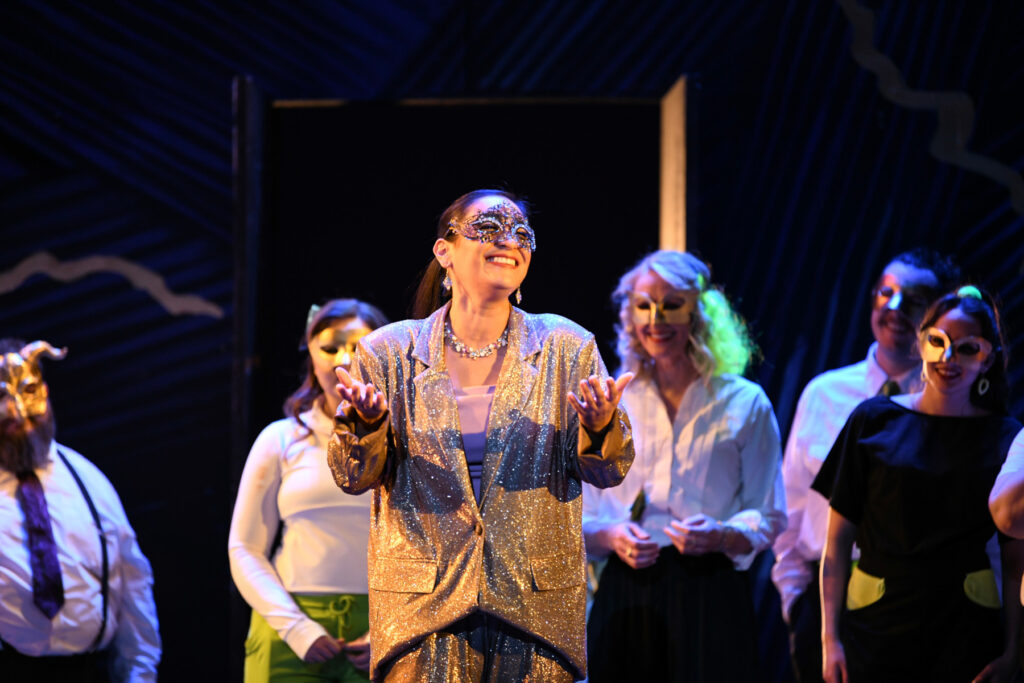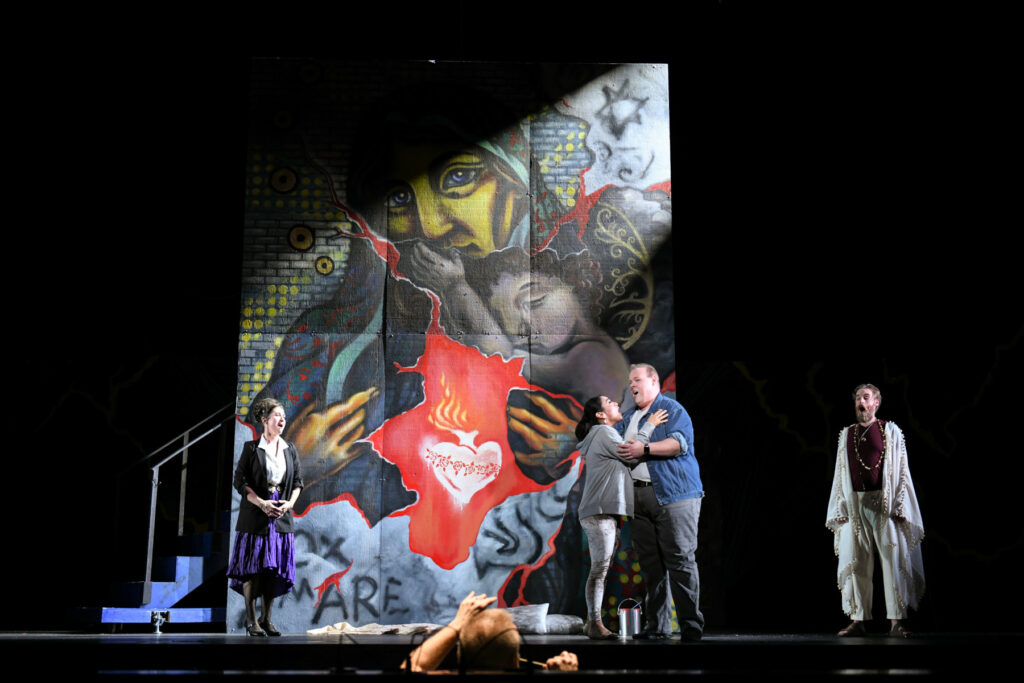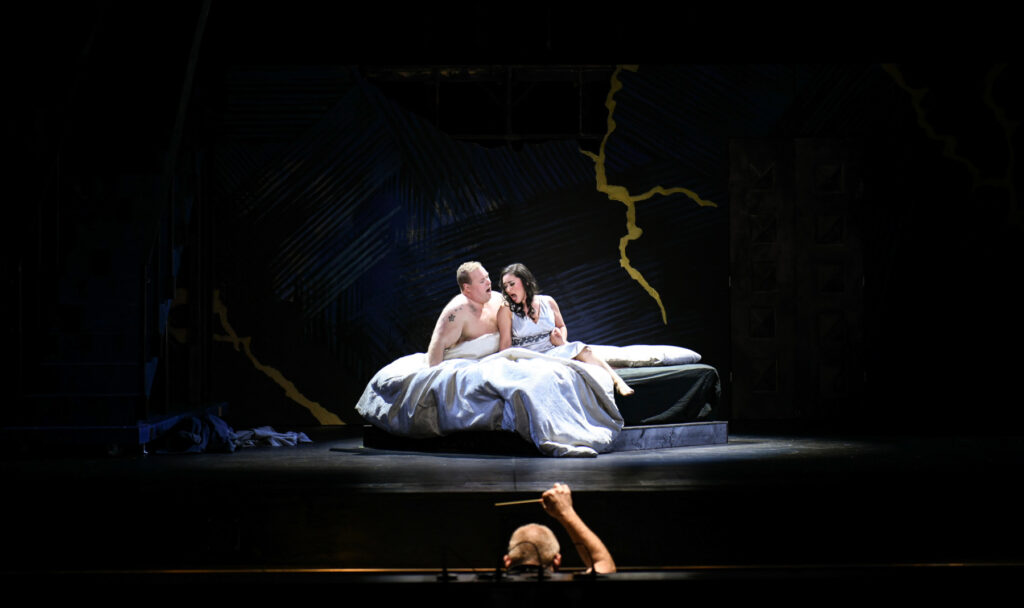Opera Idaho has gifted their public with a thrillingly sung and played performance of Charles Gounod’s tuneful and compelling take on Shakespeare’s evergreen classic tale of star-crossed love: Romeo and Juliet.
The cause for rejoicing must begin with the fact that almost all of the top-notch soloists were making highly successful role debuts including tenor Ben Gulley and soprano Cecilia Violetta Lopez, who singly and together, sang radiantly in the title roles.
Going in titular order, Mr. Gulley quite simply sang like a god. His is a gleaming, sizable instrument, rich and vibrant in all registers and at all volumes, pliable in its deployment, and lustrous in its tonal beauty. His initial joyful abandon and lovesick puppy-ness, modulated inexorably to agonizing despair. In total control throughout, Ben was a definitive proponent of this extremely demanding role. He is no longer a “rising star.” Based on this wholly persuasive role assumption, his star has “risen.” Watch for him at a major house near you. His will be a major career.

His masterful traversal was equaled by the accomplishment of our Juliette, as convincingly embodied by Ms. Lopez. Even at this first stab (pun not quite intended) at this wide-ranging heroine, the soprano is almost beyond praise. There is nothing about this gob smacked, impressionable teenager that eludes her. She has a silvery soprano that can float and enchant one minute, and in another she can pour out full-bodied, impassioned declarations as dictated by the dramatic moment.
This cherishable soprano is second to none in her uncanny ability to personify defeated grief, and her many-colored Poison Aria unfolded inexorably as a model of dramatic revelation. Based on this auspicious “first attempt,” I predict Cecilia Violetta López is poised to become Operadom’s Juliette “of choice,” on a par with her widespread acclaim as Verdi’s Violetta.
As Mercutio, Jason Detwiler offered a vibrant, lanky, peripatetic stage presence married to a virile, buzzy baritone that pinged in the house with potent force. Frère Laurent was memorably portrayed by Jeffrey Seppala, a local treasure whose poised, orotund bass enhanced every scene he was in. Another Detwiler, mezzo Michele, enlivened the role of Gertrude and lavished her part with generous, glamorous vocalizing.

Rounding out the roster of role debuts, Nicholas Cavens’ well-trained tenor was a good match for the petulant Tybalt; Anders Tobiason’s mellow baritone well served the limited vocal time as Pâris; Gregory Watts’s sturdy baritone ably delivered Grégorio’s lines; the characterful tenor of Brayden Olson was nicely suited to the demands of Benvolio; and in a case of curious casting, the plummy local mezzo Katia Hayati gamely took on the usual bass role of Le Duc de Vérone. I learned this creative thinking was owing to a cast withdrawal rather late in the process.
Two artists had previous experience with their roles, and it showed. Mezzo Cornelia Lotito gave an assured turn in the trousers role of Romeo’s page, Stéphano, her plush tone and pert delivery easily nailing the famous aria, Que fais-tu, blanche tourterelle? Veteran baritone Adelmo Guidarelli commanded his every scene as Comte Capulet and found a meaningful and affecting emotional arc transforming from the domineering father to the grieving patriarch, who sowed the seeds that led to his own consuming sorrow. Although, Mr. Guidarelli was slightly indisposed, his burnished legato singing still made its effect, and his domineering proclamations were overwhelmingly powerful as they rang out in the theatre. His keening over the bodies of first Tybalt, then Juliet were among the most honestly heartfelt moments in the entire show.
Chorus Master Kelly Kaye achieved impressive results with her beautifully prepared ensemble. They established a very high musical bar in the opening selection, and sang with insight, excellent musicianship and, save for the occasional errant French “u,” with very good diction.
In the pit, Andy Anderson ruled supreme and, after a few scrappy moments in the opening pages, he settled the talented players into a powerful ensemble, as he presided over an idiomatic reading that was fluent, well-shaped, and characterized by one enthralling high point after another. There were some especially affecting passages from the low strings, there were countless lovely woodwind solos, and the stinging brass added fire and punctuation to the fight scene and more. Maestro Anderson proved to also be a very successful collaborator, which inspired and supported the excellent singing onstage.
With all this abundant talent and unity of musical purpose on display, conversely, I found Jennifer Williams’ staging to be largely unfocussed and inconsistent. The program notes furthered the idea that this was to be a modern day, nay timeless version of a tragic story of warring clans, that has all too much resonance in today’s world. There is a good deal of merit in that well-intended thought. But the resultant potpourri of unrelated, and unrelatable visuals, were rife with what a director friend of mine calls: The Distractor Factor.

To name a few: In the ball scene of Act I, cast members proudly show off an antlered deer head, which is alternately revered, and passed around like a party favor. I never understood its presence (unless it was a “stag” party?). During Mercutio’s wonderfully delivered Queen Mab aria, two prankish boys brought on a naked female doll, which they inflated with a hand pump, then pawed a blindfolded Romeo with it, all but completely obliterating the singing. And of course, there were the ubiquitous cell phones used to take selfies with the glamorous Juliette.
The stage movement was performed with commitment but was not always well pointed and did not do nearly enough to identify the character relationships and tribes. The puzzling choreography found the cast gyrating with a combination of squishy Twyla Tharp flailing arms and regimented Richard Simmons Sweatin’ to the Oldies footwork. The duel scene had all the menace of a pillow fight, with combatants swishing their switch blades almost comically wide of their mark.
I have to say, when various such silly antics died down, and the piece boiled down to the one-on-one telling of the actual story, the connection that was fostered between the lovers was well-considered, sincere, and very engaging. I loved the giggling wedding scene when the two kids are still giddy over their good fortune. And the solos that were staged with absolute honesty to the writing, like Juliette’s Poison Aria, and Roméo’s Ah! lève-toi, soleil!, were staggering in their gimmick-free impact.
Ms. Williams obviously has talent, and she has some impressive credits on her resumé, a number of them in Europe, where one often encounters such Konzept productions at state-subsidized houses. Non-profit companies often stick with “safer,’ more “traditional” stagings since they need to appeal to donors and patrons. Maybe a younger hipster crowd was engaged by this interpretation, and if so, great. But I can say that I counted over seventy older patrons leaving at intermission.

The overall design, too, had variable results. Scenic co-designers Nico Hewitt and James Haycock have devised what is essentially a decent unit set. For some reason, there were swaths of fabric that hung on the three walls of the box at first. These got pulled off like dust covers, which were then frolicked with by the choristers. The reveal was not a “wow” moment, but the structure’s abstract painting design, and partially “torn away” walls, did ably suggest the “warring clans” concept of civil and personal strife.
There was a very tall, castered set of stairs that teetered back and forth ever so slightly, but ever so alarmingly when it was mounted by cast members. These stairs got repositioned with much commotion of noisy brake release, and subsequent re-set thumping, that was an especially unfortunate background during the orchestra’s gorgeous reading of the Act III prelude.
A truly handsome visual was the very large religious painting receiving the finishing touches by a hippy graffitist, in the person of Frère Laurent. Another lovely effect was created when the up center wall was flown to reveal a handsome “forest” of skewed wooden posts that held up the stage platforms above. The set actually worked best when it attempted the least, as in the bedroom and tomb scenes from which the stairs were blessedly out of visual play.
Danielle Adkins’ colorful costumes were all over the place, but they certainly brightened up the gloom of the scenery. How they furthered the “warring clan” idea is unclear, but they did run quite a gamut, from tees and slacks with chartreuse accents, to Goth leather pants and vest, to the odd courtier costume, to street punk, to, well, name something! I quite liked Gertrude re-imagined as a society hostess with a long cigarette holder, loitering around the ball dispensing attitude and oozing disapproval. She morphs into a second mother figure to Juliette.
In a jarring choice, when Juliette first appeared at the ball, she was in a gold sequined pants suit with matching platform pumps, with her hair in a stylish ponytail, and fully made up for the red carpet. Ms. López looked stunning, but by the time she showed up on the balcony in a form-fitting slacks and top, she looked more “Kitten-With-a-Whip” than an inexperienced teen. But I loved the hoodie she wore when sneaking off to get married, and in the second half, she was attired in much more situation-appropriate smocks.

Mr. Gulley was also not helped by his “Walmart-shopper” unflattering street clothes and jacket, as his tall, burly frame is already counter to the usual look we have in mind for Roméo. But thanks to Ben’s boyishly grinning face, and melting singing, if the duo’s first encounter did not quite work as “love at first sight,” it definitely succeeded as “love at first sing.”
Carolina Ortiz’s lighting design opened the show with a stylish light sculpture suggesting floating stars, that hovered over the head of the intoning chorus. After a subsequent rather disorienting and restless disco type display during the ball, her choices were well-considered and supported the intent of the action. She also incorporated some wonderful specials, most chillingly the side lighting that creeped me out when Tybalt’s zombie appearance invaded Juliette’s space as she sang about his corpse in the Poison Aria.
Hair and make-up designer Danyale Cook did accomplished work throughout, adeptly matching appropriate hairdo’s to the various disparate costume choices. She definitely helped establish and communicate the characters, and I especially liked the Mohawk sported by Mercutio.
A new General Director is barely two months into her tenure, having made no artistic decisions as regards this production. It will be interesting to learn how audiences inform her of their tastes, preferences, and how they will help her determine and shape the company’s way ahead. Now in its fifty-first season, the public seems to realize the enduring cultural jewel called Opera Idaho, that they have in the midst of their beautiful city.
I hope they also realize that the sensational musical achievement of Roméo et Juliette was of the highest order and should be as widely celebrated as it was lustily cheered after the final performance.
James Sohre
Roméo et Juliette
Music by Charles Gounod
Libretto by Jules Barbier and Michel Carré
Based on William Shakespeare’s Romeo and Juliet
Cast and production staff:
Juliette: Cecilia Violetta López; Roméo: Ben Gulley; Frère Laurent: Jeffrey Seppala; Comte Capulet: Adelmo Guidarelli; Mercutio: Jason Detwiler; Stéphano: Cornelia Lotito; Gertrude: Michele Detwiler; Tybalt: Nicholas Cavens; Pâris: Anders Tobiason; Grégorio: Gregory Watts; Le Duc de Vérone: Katia Hayati; Benvolio: Brayden Olson; Conductor: Andy Anderson; Director: Jennifer Williams; Scenic Co-Designers: Nico Hewitt and James Haycock; Costume Designer: Danielle Adkins; Lighting Designer: Carolina Ortiz; Hair and Make-up Designer: Danyale Cook; Chorus Master: Kelly Kaye
All photos by Fernando Menendez